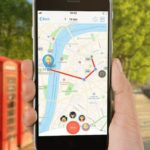Geofencing: A Comprehensive Guide
Geofencing is a powerful technology that enables organizations to leverage location-based information to create virtual boundaries around specific areas. When a mobile device or object crosses this boundary, the system triggers specific alerts and actions.
An Overview of Geofencing
What is Geofencing?
Geofencing (sometimes written as “geo-fencing”) is a method that utilizes geographical location data to establish virtual boundaries around a defined area. When a mobile device or object enters or leaves this boundary, the system detects it and triggers specific responses.
/fptshop.com.vn/uploads/images/tin-tuc/180644/Originals/Geofencing-1.jpg)
This technology is commonly employed in applications such as managing field personnel, tracking and managing vehicles or assets, offering location-based advertising or notifications to mobile users, and enhancing geographic security.
For instance, a company can set up a geofence around their business premises or operating area. When an employee moves outside of this boundary, they can receive targeted notifications or have their time and location data recorded.
The primary objective of geofencing is to optimize location-based management and user engagement based on their physical location.
How Does Geofencing Work?
Geofencing utilizes positioning technologies like GPS, Wi-Fi, or Bluetooth to determine the location of mobile devices. When the mobile device enters or exits an area defined by a virtual boundary, the system detects it and triggers specific actions.
/fptshop.com.vn/uploads/images/tin-tuc/180644/Originals/Geofencing-2.jpg)
These actions typically involve sending notifications to the user, logging location data, sending information to a management system, and more. This can assist organizations in managing scenarios such as tracking employee locations, delivering localized advertising, or automating store controls.
Geofence setup and management are often performed through location-based management platforms or software. The technology requires integration between hardware (such as mobile devices) and software (such as mobile applications or management systems).
Applications and Benefits of Geofencing
Mobile Devices
When using geofencing on mobile devices, users can configure automated actions or notifications based on their location.
/fptshop.com.vn/uploads/images/tin-tuc/180644/Originals/Geofencing-3.jpg)
For example, when individuals enter or leave a predefined area (e.g., their home, a store, or their company), they can receive specific notifications or trigger various actions. These actions may include launching a relevant app, sending messages to others, or changing settings on their phone.
In some cases, geofencing is also employed to deliver localized advertising content or information based on the mobile user’s location. As a result, users can leverage geofencing to enhance their personalized and location-based social media experiences.
Transportation
Geofencing finds extensive applications not just in mobile device management but also in monitoring and controlling vehicles in the transportation and logistics industries.
/fptshop.com.vn/uploads/images/tin-tuc/180644/Originals/Geofencing-4.jpg)
By utilizing GPS positioning systems, transportation companies can create restricted zones or checkpoints to track vehicle locations, optimize routing, and manage operating hours. This contributes to increased traffic safety, reduced fuel wastage, and improved response times when needed.
Agriculture
/fptshop.com.vn/uploads/images/tin-tuc/180644/Originals/Geofencing-5.jpg)
In the agriculture sector, geofencing is utilized to track and manage livestock. By establishing virtual boundaries around grazing areas or pastures, farmers can effectively monitor the location of their livestock and receive alerts if they venture outside the designated areas. This solution enhances the security of livestock herds and enables more efficient management.
Drones
In the field of unmanned aerial vehicle (UAV) operations, geofencing technology is employed to ensure that UAVs operate within designated areas and adhere to aviation safety regulations. The technology serves to establish virtual boundaries around no-fly zones such as airports, prisons, residential areas, or restricted airspace.
/fptshop.com.vn/uploads/images/tin-tuc/180644/Originals/Geofencing-6.jpg)
When a UAV approaches or crosses a defined boundary, the geofencing system triggers alerts, disables operation, or requests confirmation from the operator before proceeding. This ensures that UAVs do not enter restricted airspace and helps maintain the safety of the airspace.
Examples of Geofencing Applications
Social Networks
Geofencing plays a significant role in conjunction with social media platforms. The technology helps make user experiences more contextual and personalized based on their geographic location. As users move in or out of specific areas, they can receive localized information, promotions, local events, or even interactive content from businesses and organizations.
/fptshop.com.vn/uploads/images/tin-tuc/180644/Originals/Geofencing-7.jpg)
Furthermore, geofencing also enables social media platforms to gather location data in order to display relevant information and activities to users. This is of great interest to businesses and the online advertising industry, as they can target their advertising campaigns based on specific locations.
Marketing
In the marketing domain, geofencing empowers businesses to customize and optimize their marketing campaigns based on the geographic location of their customers. By utilizing location-based technologies, businesses can create virtual boundaries around specific areas of interest. When customers enter or leave those areas, they can receive exclusive promotions or notifications from the business.
/fptshop.com.vn/uploads/images/tin-tuc/180644/Originals/Geofencing-8.jpg)
Geofencing also helps businesses track customer activity in real time, providing data about their consumer behavior and engagement with products or services. As a result, businesses can create more effective marketing campaigns, drive engagement, and build deeper relationships with their customers.
Telecommunications
Geofencing finds applications in the telecommunications sector by enabling technology companies to set up virtual fences around their sites, work areas, and secure zones. When triggered by external agents, these virtual fences send alerts or notifications to operators.
How to quickly locate Android and iPhone phones
Why do you need to install phone tracking? How do you set up the location mode between 2 phones? With just 1 click on Google, you will receive countless guiding results, which makes it difficult to determine the most suitable method for your device. Let’s explore with FPT Shop the best way to install phone tracking for different platforms.






































